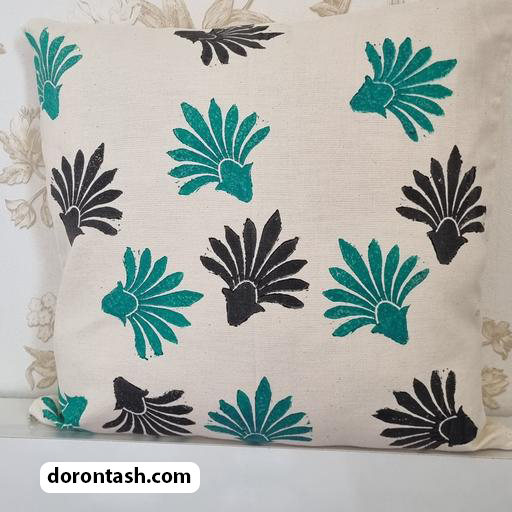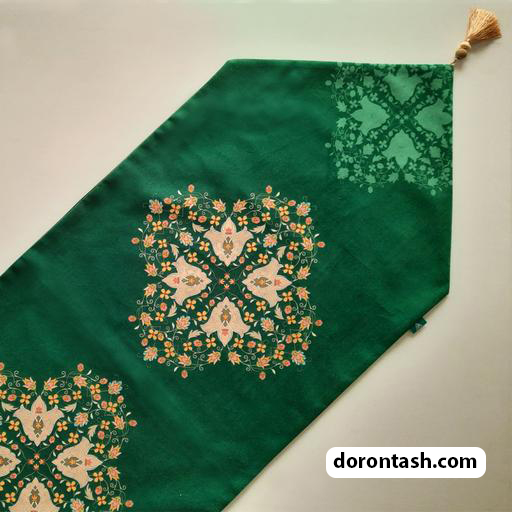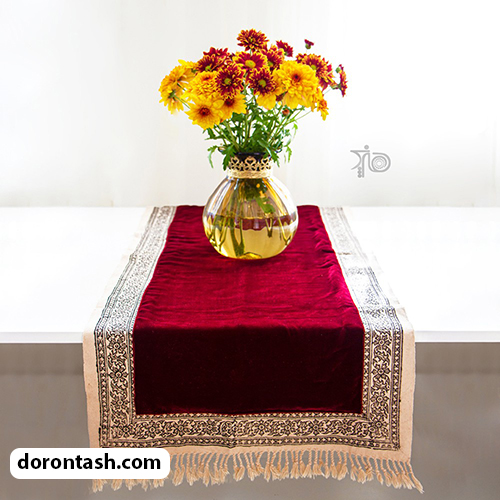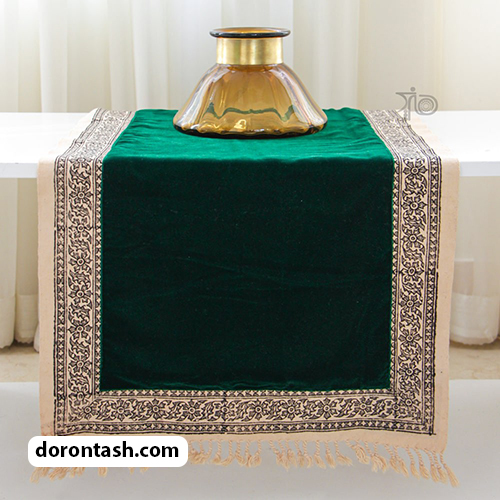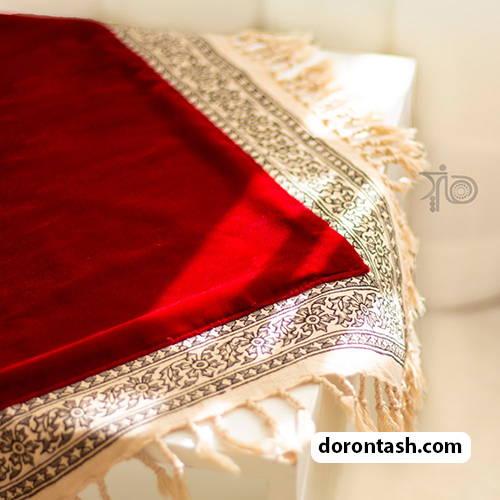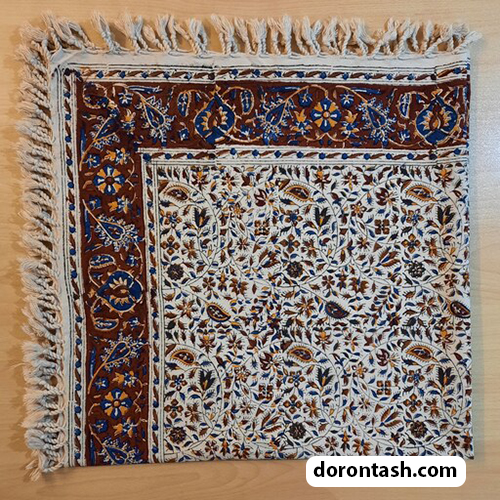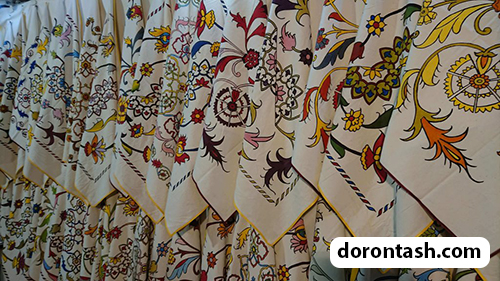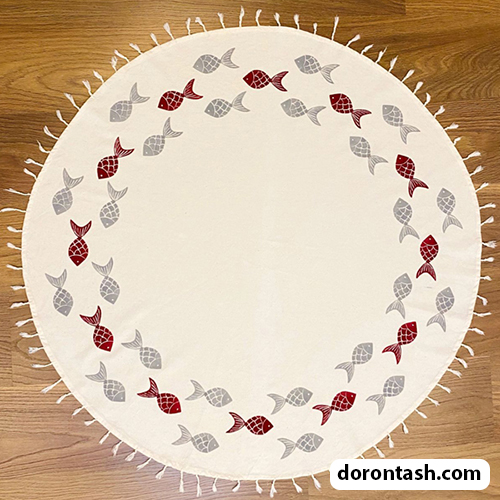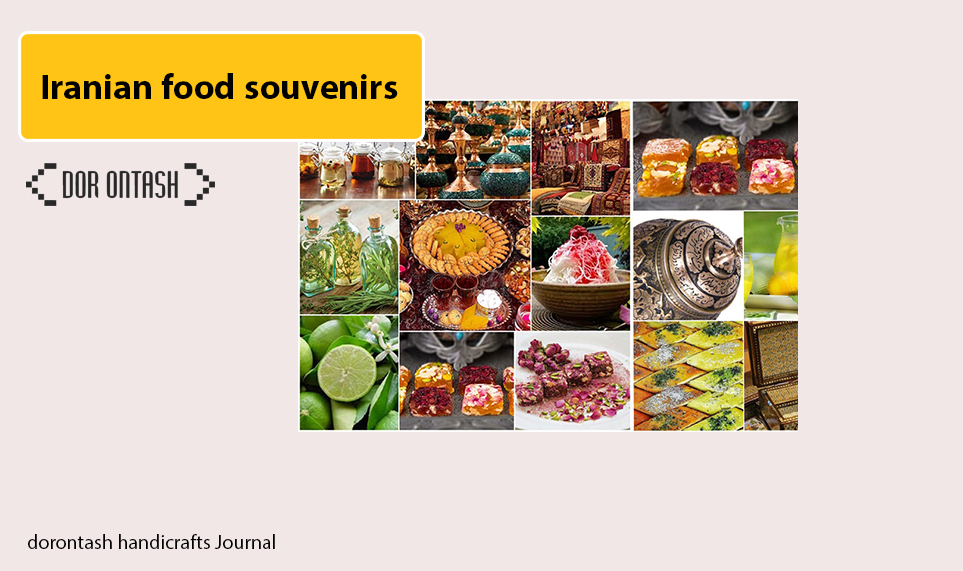The characteristics of hand-made cashmere art and calligraphy

persian ghalamkari cloth and cashmere are one of the most famous handicrafts in Iran, which attract foreign tourists and are known as Iranian souvenirs all over the world. The art of calligraphy is the ancient art of hand printing on cotton or silk fabrics with natural colors. On the other hand, one of the most famous Iranian handicrafts is terme, which is a special fabric made of silk or wool. Cashmere is a luxurious fabric that was used in the past to make clothes for elders, but today it is used to make tablecloths, bedspreads and rugs. In this article from Artina, we discuss the difference between kalamkar fabric and cashmere.
Uses of persian ghalamkari art and penmanship that you didn’t think of!
Cashmere and penmanship is one of the handcrafts of Iranians, which flourished in Isfahan during the Safavid period. Cashmere is a kind of precious cloth woven from very soft fibers and persian ghalamkari is the art of printing on cloth.
In the past, these exquisite fabrics were mostly used in men’s and women’s clothes. At the present time, Iran lovers and art lovers who want beauty and authenticity together use this beautiful Iranian art in their home decoration.
These authentic fabrics are eye-catching in any setting, whether modern or traditional. Salam Art Creations Complex has used this design and Iranian Islamic art in the design of tablecloths, desks and janmaz, which is considered a special gift in addition to personal use.

Introduction of persian ghalamkari fabric
The art of penmanship is a technique of printing Iranian patterned fabric, which is done using wooden stamps. Carving molds are mostly made of pear wood, which has better flexibility and density for carving and long-term use. There are hundreds of different patterns on the types of Qalamkar fabrics, including Arabic designs, plant and animal designs, geometric designs, pre-Islamic designs, hunting scenes, polo games, Persian poems and calligraphy, Armenian and Hebrew inscriptions.
ghalamkari is also known as ghalamkari, which is basically a type of cotton textile that is painted or printed by hand. Isfahan is one of the most important cities that produce kalamkar fabrics all over the world. In fact, Qalamkar means “paid with pen and ink”. It should be noted that it was produced in the same way in the beginning.
The history of penmanship | The art of cashmere and handmade penmanship
Another difference between Qalamkar fabric and cashmere is the history they have gone through. The Chinese brought beautiful and patterned clothes to Iran through the Silk Road and won the hearts of Iranians with these colorful gifts. Inspired by these beautiful textiles, Iranians also invented the native version of patterned cloth, that is, Qalamkar. Kalamkar is known as Kalamkar in India, although Indian Kalamkari consists of twenty-three stages and is different from Iranian Kalamkari.
This art dates back to the Sasanian period, the fourth Iranian dynasty and the second Iranian empire (224-651 AD). Since then, Iranian artists used pen and ink to draw detailed and stunning designs on the fabric. Of course, this art flourished in the 11th century AH, during the Safavid period. One of the most important reasons for this was Shah Abbas’ interest in this art. Qalamkar cloth was quickly noticed by the Iranian elite class. Then the art of penmanship expanded even more and its development continued until the Qajar period.
Due to its exquisiteness and eye-pleasing beauty, Qalamkar cloth became the favorite clothing of Safavid emperors. Safavid kings, nobles and upper class wore silk and cotton kalamkar clothes decorated with gold and silver. Also, Qalamkar fabrics were used to decorate the interior, which were often used as curtains, bedspreads, and wall coverings.
Many calligraphy workshops were always active all over Iran. Shiraz, Yazd, Borujerd, Kashan along Isfahan (the main production centers of this type of printed fabric) had unique productions. At present, Isfahan and especially the city of Khorzouk is one of the most important producers of pen products in the world.
Although with modern architecture and today’s luxury appliances, recreating the warm atmosphere of traditional Iranian houses with stucco, hand-woven carpets, beautiful arches, inlaid windows, etc., seems a little far-fetched, but the use of small items such as Kalamkar’s table cloths Or cashmere in the home space, in addition to creating a sense of nostalgia, is a respect, albeit a small one, for the original Iranian art.
The originality and simplicity of the beautiful bateh and jakeh designs along with happy and intense colors or in some designs, soft colors can distinguish the signature of your home arrangement from others. In Iranian art, designs and flowers also have metaphorical meanings. For example, some people believe that the design of the jacket and its bowed head is a symbol of the bowed head, which represents the humility of Iranians.
Kalamkar design notebooks with slim and elegant designs double the taste of recording memories and making the daily life last for the owner of these notebooks.
Cashmere and persian ghalamkari cloth: difference in applications
These two works of art have significant differences in terms of application . One is more practical and the other is more decorative. This is the reason why their prices are different. The most important practical difference between kalamkar fabric and cashmere is as follows:
- Cashmere is included in the category of luxury works of art, that’s why they use it mostly for decoration . For example, during Nowruz, cashew is considered as Haft Sin table. Qalamkar fabric is also used as a tablecloth, but this work of art is not as highly decorative as cashmere.
- In the distant past, very valuable and expensive clothes were woven from cashmere . These clothes were usually worn by courtiers or very important people. Qalamkari cloth has been welcomed and used by the general public due to its cheapness. Today, few people sew clothes with cashmere or kalamkar fabric, but if they use them to sew or decorate clothes, cashmere is still considered more expensive.
- Painting fabric is produced in all sizes, large and small . For this reason, they make large and varied curtains from these fabrics. Due to the lightness of the Qalamkar fabric, there is no limit to its dimensions. But cashmere is a heavy fabric . Although it has been seen that they make curtains with cashmere, but these curtains cannot have the quality of kamkari cloth due to their thickness. Cashews are usually small in size and are used as tablecloths for small tables.
- Cashmere and ghalamkar cloth are both used for clothes, janmaz, tablecloths, rumbly and generally as gifts. But the main difference is that the use of cashmere for anything makes it more expensive and it is mostly used by those who have a high income. But ghalamkar cloth itself has a reasonable price and when it is considered as a tablecloth or a dress, it can be used by all levels of clothing.

What is the difference between cashmere patterns and persian ghalamkari fabric?
Handicrafts acquire meaning with the motifs depicted on them. Before we examine the motifs worked on these two works of art, you should know that the background of cashmere is always colored , but the background of ghalamkar cloth is usually considered white . Because the penman has the same authority as the painter who wants to paint on the canvas. In fact, the fabric is considered the artist’s canvas. The most important differences between these two arts in terms of motifs are as follows:
- Patterns are pre-woven on cashmere fabrics . But the artist must draw patterns on the cloth with a brush or print or engrave it on the cloth with the help of a wooden template.
- Bete Jaqe is a fixed pattern in Iranian cashmere , which researchers emphasize that this design is considered one of the important symbols of Zoroastrianism. Sometimes this design is placed in the middle of the cashmere cloth and the artist sews and fills it around or inside with pearls or vermilion using a special needle and thread. This design is sometimes placed in the background and sometimes in the center of the fabric .
- The Qalamkar cloth has a good size. For this reason, Qalamkarsaz can narrate important motifs such as “historical works, stories of history lovers, famous literary stories, flowers, chains, borders, miniature motifs, inscriptions and old royal hunts” by painting on cloth. But there is no such thing in Termeh . Perhaps the similarity between cashmere and Qalamkar fabric is more in the context of dealing with the role of nature . The main motifs of cashmere include “Bete Jaqeh, Shah Abbasi flowers, abstract and Slimi lines”.
- The pen artist can paint the motifs he wants on the fabric. Some do this coloring by hand and some go to the mold. There is no coloring in cashew . The artist must sew the desired motifs with silk, pearls and braid. Cashmere is the art of sewing on fabric. Calligraphy is known as the art of painting and painting on fabric.
- In calligraphy art , three main colors are used , i.e. “black, red, blue, green, yellow” . Depending on what design the artist has painted or printed on the fabric, other colors are also used. It means that other colors are obtained from the combination of 5 main colors.
- Cashmere cloth is the opposite of kalamkari cloth. In order for the cashmere fabric to have different colors, colored threads should be used when weaving it. The variety of colors in cashmere fabric is very large. But the variety of colors in kalamkari cloth is not as much as cashmere.
How to make persian ghalamkari cloth
The process of printing Iranian textiles or kalamkari starts by washing the starched fabrics until the fabrics are soft. After drying, the fabrics are ready for printing. Cotton, silk and linen are used for penmanship because these fabrics absorb ink quickly.
To design and dye the ghalamkar fabric , artists place it on a short table and use patterned ink and stamp to design the fabric. Wooden molds are mainly made of flexible wood such as pear wood or hawthorn. These pieces have several different patterns and motifs, from plant and animal designs to Arabic or geometric motifs. Some also show the hunting scene, some lovers holding hands or verses from Persian poems.
Blue, red, black, green and yellow colors are the main colors of calligraphy. Traditionally, dry pomegranate skin, saffron, turmeric, black plum and dried herbs were used for natural dyeing of Qalamkar fabrics. But today, paint and chemical compounds are used in calligraphy.
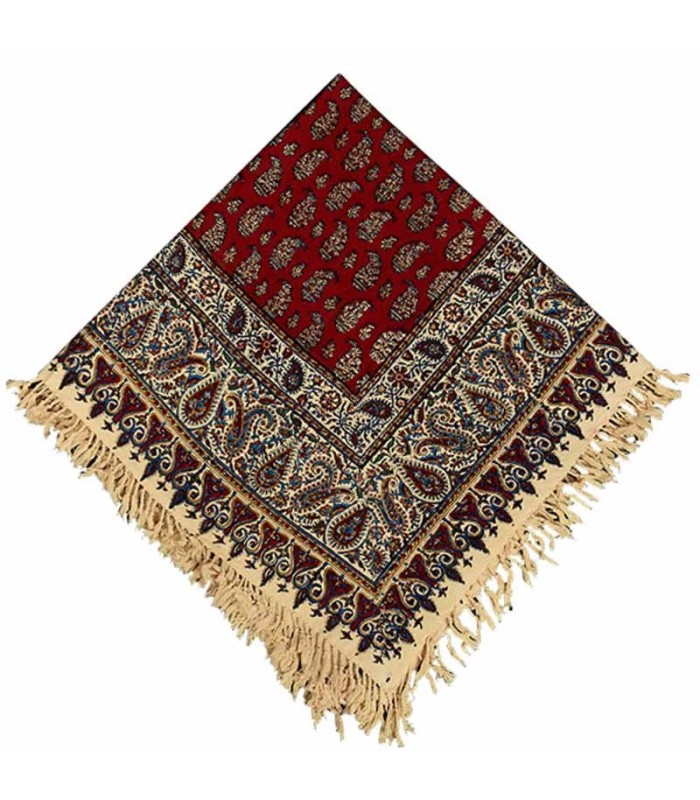
A look at the texture of cashew
If they want to weave cashmere by hand, they must use high quality silk, wool and thread in its preparation. In the machine example, cashmere is woven with artificial silk or polyester. Cashmere weaving is very laborious and the finished price is twice that of machine weaving . For this reason, today many artists weave cashmere by hand.
After the cashmere weave is finished, the prepared fabric is sold so that the cashmere embroiderers sew beautiful designs on the cashmere with different methods. In cashmere embroidery, depending on what the artist wants to fill the designs with, the tools and equipment used will be different.

A look at the design of persian ghalamkari fabric
Usually, for painting on cloth, the cloths are prepared in ready form. The materials used for penmanship are silk, canvas, motagal, chalwar and linen . The artist draws the desired design on parchment paper and when it is finished , transfers it to the wooden mold .
The design is carved on a wooden template with a knife or chisel to highlight the motifs. Then the mold is dipped in the desired color and printed on the work by hitting the mold. There are other steps in the Qalamkar fabric. When the work is finished, the fabric is washed and dried in several stages with different methods so that the color is well fixed in the fabric. The raw materials and tools used in calligraphy are many and varied. The most important of them include “mould, table, bedspread, mortar, potil, goblet, varnish, ear scarf, leaf, hand bumper and straightener”.
Elegant Iranian mothers always consider prayer tents and special shrines for the dowry of their young daughters, and choosing pen designs is a smart and elegant choice for this spiritual gift.
Salam Art Creations Complex hopes that the originality and vitality of Iranian art will flow in the spirit of life of the countrymen of this border by using calligraphy designs and cashmere art in all kinds of everyday items.
The process of sewing and production of cashmere
To sew high-quality cashmere, which is usually prepared in cashmere embroidery centers of Iran, i.e. Isfahan, Yazd, Kashan, Kerman and other cities of Iran, it is necessary to go through some steps. After familiarizing yourself with these steps, you will notice the difference between kalamkar fabric and cashmere. These steps are:
- Collect some wool
- Washing wool
- Classification of wools based on their color
- Pattern drawing to recognize designs and colors with their specific locations and overlays
- wrapping; They spin about 2000 to 3000 threads to have enough thickness
- Stretching and applying pressure to the threads
- Threading
- Coloring the design pattern
- weaving
Knowing the difference between kalamkar fabric and cashmere; Selection and purchase guide
Cashmere art and handmade penmanship are two of the most important handicrafts in Iran, which are known all over the world. Perhaps the difference between Qalamkar fabric and cashmere fabric is great, but both of them have one point in common, and that is the cultural importance of these two fabrics. With the tips we shared with you about the difference between these two types of Iranian handicrafts, you can make the best choice and buy in this field.
Examples of work from Termeh and persian ghalamkari
